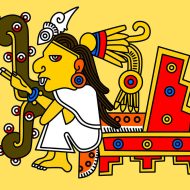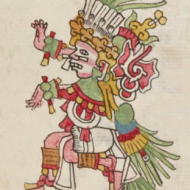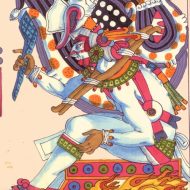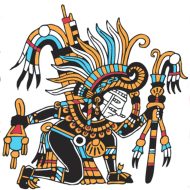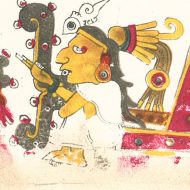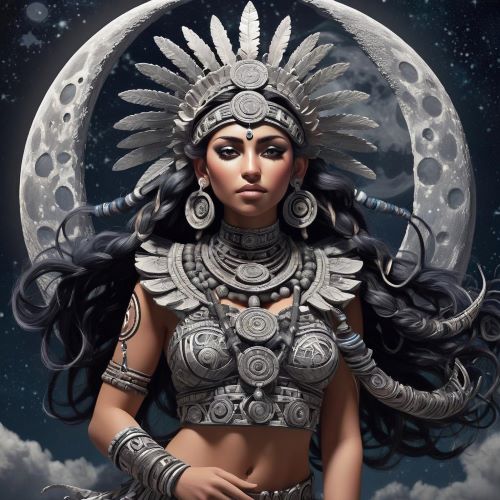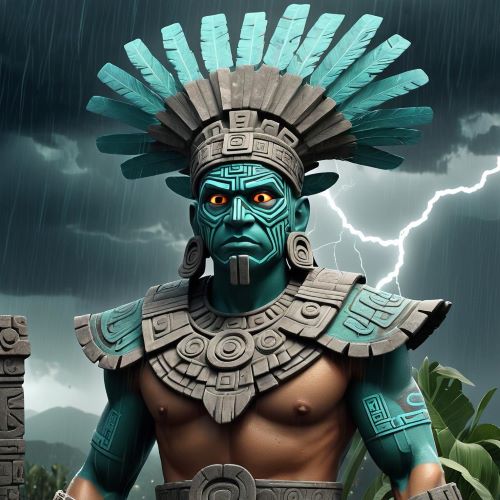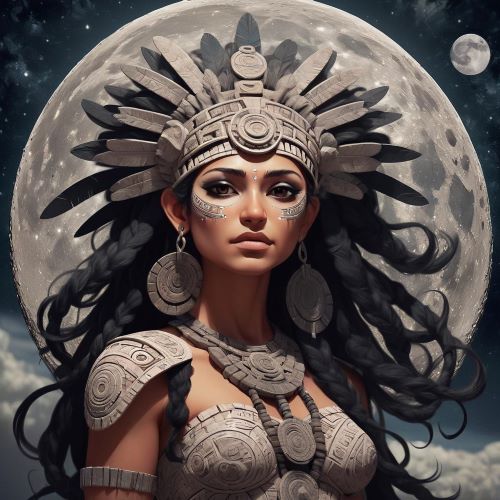Tecciztecatl : The Moon God
Listen
At a glance
| Description | |
|---|---|
| Origin | Aztec Mythology |
| Classification | Gods |
| Family Members | Tlaloc (Father), Chalchiuhtlicue (Mother) |
| Region | Mexico |
| Associated With | Moon, Tides |
Tecciztecatl
Introduction
Tecciztecatl, the revered Aztec deity associated with the moon, occupies a significant and captivating role within Aztec mythology. Born of divine parentage, Tecciztecatl confronts a formidable challenge that ultimately results in his transformation into the embodiment of the moon. His divine representation is laden with symbolism, including the imagery of a conch shell, and he holds rulership over the sixth day in the Aztec calendar.
According to Aztec beliefs, Tecciztecatl is recognized as the deity presiding over the moon. His mythological narrative, intertwined with themes of courage and perceived weakness, highlights a cosmic drama that unfolds against the backdrop of creation. Envision a primordial fire flickering at the dawn of existence, from which emerge two celestial beings: the proud and opulent Tecciztecatl and the humble and self-sacrificing Nanahuatzin. Chosen to embody the sun and the moon, their divergent personalities set the stage for a cosmic spectacle that shapes the celestial order.
In this cosmic drama, Nanahuatzin boldly embraces his role, leaping into the fiery embrace to become the radiant sun. In stark contrast, Tecciztecatl hesitates, succumbing to fear. As a consequence of his reluctance, he is relegated to the lesser role of the moon, forever marked by the symbol of a rabbit. This emblem serves as a perpetual reminder of his diminished luminosity, condemning him to an eternal pursuit of the sun across the vast expanse of the night sky.
Physical Traits
In various portrayals, Tecciztecatl is depicted with distinctive attributes, enhancing his mythical persona. In one representation, he bears a substantial, white seashell, known as tēucciztli in Nahuatl, symbolizing the Moon itself. Another depiction endows him with ethereal butterfly wings, adding a touch of otherworldly grace.
A significant symbol intricately linked with Tecciztecatl is the conch shell. Within Aztec culture, the conch shell carries profound symbolism, representing notions of beauty, purity, and the divine. Tecciztecatl is frequently illustrated holding this emblematic conch shell, symbolizing his intimate connection to the Moon and its potent transformative energies. Often depicted as an elderly figure, Tecciztecatl embodies the wisdom intrinsic to the cyclical nature of the moon. His form is adorned with butterfly wings, serving as a symbol of rebirth and transformation.
However, the most prominent feature that defines Tecciztecatl is the sizable, white seashell adorning his back, symbolizing the very essence of the moon. In certain renditions, he clutches a rabbit, an ever-present reminder of his diminished radiance and the celestial race destined to be run for eternity.
Family
Tecciztecatl’s lineage can be traced to the divine union of Tlaloc, the god of rain, and Chalchihuitlicue, the goddess of water. Emerging as the progeny of these formidable deities, Tecciztecatl inherits profound cosmic responsibilities and attributes. His parentage establishes a profound connection to both the celestial and earthly realms, mirroring the moon’s influence on tides and the intricate rhythms of life.
As part of a divine couple, Tecciztecatl and Tonacacihuatl actively contribute to the generative forces that uphold the cosmic order. Their intertwined destinies serve as a testament to the intricate interplay of deities within Aztec mythology, wherein familial bonds are intricately woven into the very fabric of the universe. The sacred connection between Tecciztecatl and his divine lineage underscores the seamless integration of celestial and earthly realms, emphasizing the significance of their roles in shaping the cosmic tapestry.
Other names
Apart from being recognized as Tecciztecatl, this lunar deity is also acknowledged by alternative names such as Tecuciztecal and Teucciztecatl. Tecuciztecatl, a variant of his primary name, adds another layer to the multifaceted identity of this celestial being. Titles like “He who comes from the land of the sea-slug shell” and “He who paints the night” provide additional insights into his lunar essence, emphasizing the diverse facets of his cosmic influence.
Another name associated with this moon deity is “Metztli,” a term intricately linked to the Aztec word for the moon, “metztli.” This alternative appellation enriches the spectrum of names used to invoke and recognize the influence of Tecciztecatl, showcasing the nuanced ways in which this deity is conceptualized within Aztec cosmology.
Powers and Abilities
In his capacity as a lunar deity, Tecciztecatl is believed to wield formidable power, presiding over the moon, its cyclic phases, and the enigmatic expanse of the night sky. His significance extends to a pivotal role as the ruler of the sixth day within the tonalpohualli, the sacred calendar of the Aztecs. This prominent position symbolizes Tecciztecatl’s authority and influence over time, embodying the cyclical nature intrinsic to the universe.
Tecciztecatl’s potency is rooted in his dominion over the night, wherein he governs the intricate cycles of the moon, exerting influence over phenomena such as tides, fertility, and the nocturnal realm. His luminosity pierces the darkness, providing guidance to travelers and casting long, evocative shadows. Associated with dreams, intuition, and the profound mysteries concealed within the depths of the human soul, Tecciztecatl stands as a celestial force shaping the mystical aspects of the night.
Modern Day Influence
In the contemporary era, Tecciztecatl’s influence extends far beyond the historical boundaries of ancient Mexico. His visage adorns murals, serves as inspiration for modern artists, and retains a magnetic appeal for those exploring the mysteries of the cosmos and humanity’s position within it. Whether manifested in neo-pagan rituals or interpreted through various artistic expressions, Tecciztecatl stands as a compelling symbol of lunar potency, prompting reflections on the cyclical rhythms of existence and the timeless fascination with the nocturnal celestial expanse.
Related Images
Frequently Asked Questions
What is lorem Ipsum?
I am text block. Click edit button to change this text. Lorem ipsum dolor sit amet, consectetur adipiscing elit. Ut elit tellus, luctus nec ullamcorper mattis, pulvinar dapibus leo.
What is lorem Ipsum?
I am text block. Click edit button to change this text. Lorem ipsum dolor sit amet, consectetur adipiscing elit. Ut elit tellus, luctus nec ullamcorper mattis, pulvinar dapibus leo.
What is lorem Ipsum?
I am text block. Click edit button to change this text. Lorem ipsum dolor sit amet, consectetur adipiscing elit. Ut elit tellus, luctus nec ullamcorper mattis, pulvinar dapibus leo.
What is lorem Ipsum?
I am text block. Click edit button to change this text. Lorem ipsum dolor sit amet, consectetur adipiscing elit. Ut elit tellus, luctus nec ullamcorper mattis, pulvinar dapibus leo.
What is lorem Ipsum?
I am text block. Click edit button to change this text. Lorem ipsum dolor sit amet, consectetur adipiscing elit. Ut elit tellus, luctus nec ullamcorper mattis, pulvinar dapibus leo.

